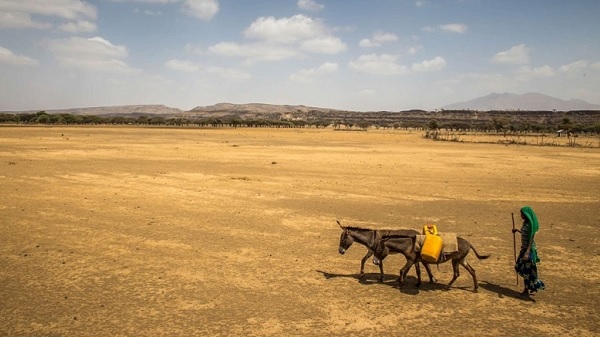
NDRMC public relations director Mr. Debebe Zewdu noted that most of the drought hit areas are low lands inhabited by pastoralist communities.
By Solomon Tesfaye (WMC) |
The National Disaster Risk Management Commission (NDRMC) says the number of drought affected people has reached 7.6 million during this month of the budget year.
Public relations director of NDRMC, Debebe Zewdu, told WMC that the number of drought affected people in the country has increased by 2, 068, 319 during the current month of April.
According to Debebe, the number of drought victims is rising due to failure of rainfall during the current “ belg ” season and crops are heated by frost incident in the last “meher ” season in Oromia, Amhara and SNNP regions, he underscored.
The Commission needs additional 432, 515 metrics tons of crops ,nutritional foods , pulses and edible oil for 2, 068, 315 extra drought victims found in different regions, he stated . The food aid is ready for distribution from the contingency food reserve of the government, he, indicated.
Debebe noted that most of the drought hit areas are low lands inhabited by pastoralist communities. The Commission is exerting integrated efforts to supply potable water and animal fodder for the drought affected ones, he underlined.
Furthermore, NDRMC has distributed 260,000 bells of animal fodder in two rounds to the highly drought hit zones of Borena , west Guji, Guji , Bale in Oromiya region and provided a total of 40,000 bells of animal fodder to Gamogofa and Segen people’s zone in SNNP.
The Ethiopian Somali and afar regions have started to develop animal fodder via irrigation to minimize the serious impact of drought on animal resources of the regions, he stated. Afar and Somali is now developing animal fodder on 1,000 and300 hectares of land respectively, he inculcated.
Civil servants and developmental investors found across the country are participating in donations to withstand the drought caused by rainfall shortage , Walta learned.
Source: Walta Information Center
——
Other stories:
- Drought: The New Normal in East Africa? Should the Indian Niño Be Blamed for Drought?
- VIDEO: UN Seeks $1.9 Million to Address Famine Situation in Drought Affected African Countries
- EU Announces €165m Additional Support for Famine and Drought Affected Countries in Horn of Africa
- German Development Ministry Pledges Additional 100 Million Euros to Drought-affected Horn of Africa
- FAO Is Committed to Walking alongside with the Communities Affected by the Drought Impacts in Ethiopia
